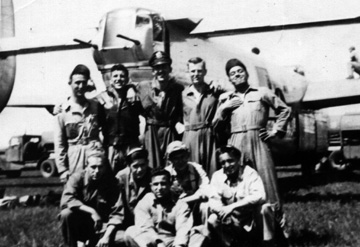|
Story of WW II Shoot Down and POW Experiences |
||||||||||||
 |
 |
|||||||||||
|
Enlistment & Initial Air Crew Training My induction into the army was at Fort Snelling, Minnesota, July 1943 and after processing I was sent, along with 20 other men, to North Fort Hood Texas, for basic training. During processing at Fort Snelling, the mention of the Army Air Force was made. So on arrival at Fort Hood, Texas, I requested a transfer to the Army Air Force. This came about mid-October and I was soon off by troop train to Gulfport, Mississippi, to a holding group for testing as to what military type of assignment I might be best suited for. I passed the pilot training exams, except for the color blind test; but, I did qualify for air crew. Again, by troop train, it was off to Tyndall Field, Panama City, Florida, for air gunnery training. Arriving about mid-March, the weather was warm and after the usual hurry up and wait we started our aerial gunnery training which included hours of shotgun trap shooting, turret operation and the firing of the turret on the ground. The ground turret trainer made you feel as though you were actually in the aircraft. Because of the number of persons taking the training, headquarters sent a group of men to a sub-base at Apalachicola, Florida, for the air part of our training (flying). That first flight was still something that I will always remember. The flight was to familiarize us with the aircraft and what it was like to fire the 50 caliber machine gun mounted in the aircraft. This was my first flight in an aircraft. The instructor was assigned eight to ten students and after a short briefing we got aboard a B-17 and off to the wild blue of our first flight. The instructor had taken many other trainees on their first flight as was the case with our group. With the noise of the engines and the open windows one could not hear unless yelled into your ear, therefore most instructions were by hand signals. His favorite trick on the new trainees was to show each how the wings would move and have them watch to see how far they moved, and then see how sick they would get. I had heard of this before so did not get sick myself. But the airstream noise and the noise from the vibration of the machine gun firing was something that the average person would not believe. After that first flight, and with small groups of four to six trainees, the rest of the aerial gunnery training went well and I graduated with no problems. Initial training completed, we shipped out in May 1944 to Westover Field, Springfield, Massachusetts, by troop train. We received our crew assignment and prepared for overseas duty. Westover was a very good, comfortable and nice town just outside the main gate. During my stay at Westover for about three months, the crew assignment was as follows: |
||||||||||||
| James M. Moye, 1st Lt.
Devon R. Hall, 1st Lt. Robert E. Zimmer, 1st Lt. Richard Weisner, 2nd Lt. John T. Scully, T/Sgt. Mario E. Dimeo (Marty), T/Sgt. Eddie-Joe Gallenas, S/Sgt. Joseph E. Roman, S/Sgt. Leonard J. Dumas, S/Sgt. John C. Schumacher, S/Sgt. |
Pilot
Co-Pilot Navigator Bombardier Engineer Radio Oper. Gunner Gunner/A-Radio Gunner (Tail) Gunner/A-Engr. |
Laurel, Miss.
Nappanee, Idaho New York, NY New York, NY Boston, Mass Boston, Mass Detroit, Mich Brownsville, Pa Malone, NY Little Falls, Mn |
||||||||||
|
Our Crew Top, L to R: Scully, Zimmer, Weisner, Moye and Dimeo Squatted, L to R: Roman, Dumas, Galenas, Schumacher Seated: Hall |
||||||||||||
 |
||||||||||||
| The training we did at Westover was in preparation for combat. We were flying as a crew on B-24 aircraft. This included night flying, day and night bombing and gunnery practice, flying every day for five to eight hours per day. Information came down from headquarters that when we completed all phases of the assigned training requirements, we would take leave before our overseas tour started. The skipper was very adamant that we finish as soon as possible and the whole crew felt the very same so we could have leave. We missed being first by one-half hour and off we were on leave, my first since induction a year before.
We were a close-knit crew. For other than the married men (Skipper & Scully) and those that lived in the area, it would be unusual to find a crew member without the rest of the crew nearby. Flying was fun and we enjoyed everything we were getting ready for, and with a crew like ours, it made life enjoyable. Whenever possible the skipper would have everyone fly the plane so if the time ever came anyone of the crew would be able to bring the aircraft home. We all enjoyed this leave very much. On our return, the magic day arrived for our departure from Westover by troop train to Mitchel Field, New York, the Overseas Processing Center. End of Chapter 2 |
||||||||||||
|
Go to Cover — Introduction — Table of Contents Chapter — 1 — 2 — 3 — 4 — 5 — 6 — 7 — 8 — 9 — 10 — 11 — 12 — 13 Or Go To Home - Contact Us - Cold War Hist. - 91st SRS Hist. - Stardust 40 Mission Story |
||||||||||||